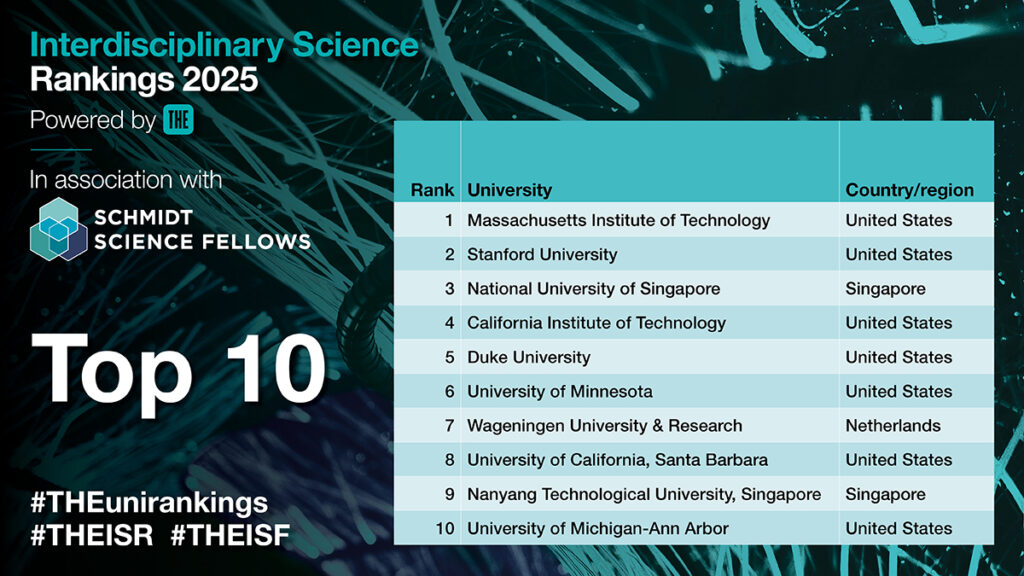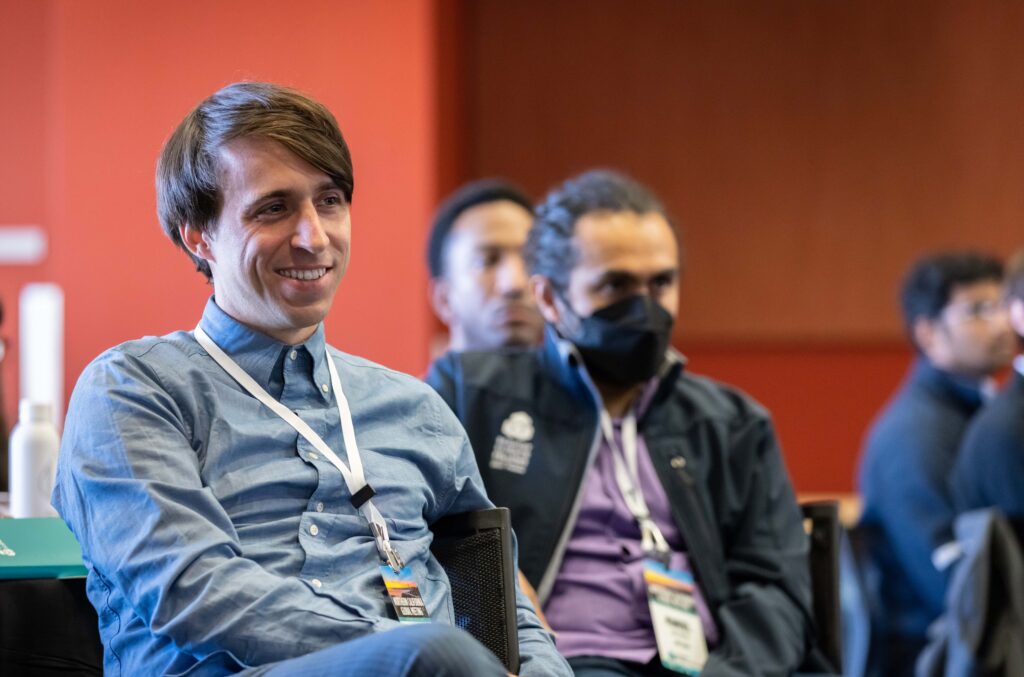Today’s Times Higher Education Interdisciplinary Science Rankings, in association with Schmidt Science Fellows, marks a transformative milestone in global research excellence.
For the first time ever, academic institutions are being robustly and transparently recognized for interdisciplinary science excellence, evaluated through detailed methodology and comprehensive data.
Explore the groundbreaking Rankings that redefine global research excellence here: http://www.timeshighereducation.com/interdisciplinary-science-rankings
This platform, the most successful Rankings debut in Times Higher Education’s (THE) history, will accelerate global progress in interdisciplinary research by championing best practices wherever it is found and by highlighting the trends and practices that are driving success.
Established centers of research excellence performed well in the inaugural Rankings with Massachusetts Institute of Technology (MIT) ranked number one. MIT took the top spot, scoring strongly across all three Rankings pillars – Inputs, Processes, and Outputs.
But strong performance and participation from across the world demonstrate the growing importance of interdisciplinary approaches to institutional success and the Rankings show a strong trend of interdisciplinary output in the emerging research regions of Asia and Africa.
Breaking Down Silos
“Human curiosity has no boundaries, and science—the way we satisfy that curiosity—should be no different,” said Wendy Schmidt, co-founder of Schmidt Science Fellows. “The universities on the inaugural Interdisciplinary Science Rankings are breaking down silos and creating new ways of pursuing knowledge, bringing us closer to transformative discoveries about ourselves and our universe.”
“To answer the world’s toughest questions—whether it’s scaling fusion energy or advancing quantum computing—we need to think differently,” said Eric Schmidt, co-founder of Schmidt Science Fellows. “The Interdisciplinary Science Rankings recognizes universities that are advancing the practice of science for the next century and beyond through new institutions, emerging technologies, and effective teaching.”

New data and analysis will promote open, engaged, and informed discussion to help institutions set strategy and refine approaches.
“This Ranking marks a pivotal step in advancing interdisciplinary research worldwide,” said Dr. Megan Kenna, Founding Executive Director of Schmidt Science Fellows. “It provides institutions with critical insights to strengthen their efforts, learn from global leaders, and create environments where innovative thinking thrives. By championing interdisciplinary science, we are not only addressing today’s most pressing challenges but also empowering future generations to drive innovation and tackle the unknowns of tomorrow.”
Global Appetite
The Rankings uncover the scale of diversity in terms of the institutions participating and the number of countries performing well across different metrics and pillars.
Phil Baty, THE’s chief global affairs officer, said: “The Interdisciplinary Science Rankings launch is the largest in the history of the global THE rankings, with 749 institutions across 92 countries ranked. This is down to the fantastic work that has been undertaken by THE working in association with Schmidt Science Fellows, and clearly demonstrates the importance and enormous global appetite for interdisciplinary research.
“Universities worldwide are using interdisciplinary science to boost innovation and to make breakthrough discoveries that help to solve the world’s biggest challenges. This ranking stands as a testament to the skills, techniques, and dedication from a broad range of scientific disciplines that drives this research forwards.”
Highly Competitive
The competition among the top five universities is strong, with only a 3.1-point difference between the 5th ranked (Duke University) and the top-ranked (MIT). The top five universities all have a strong focus on engineering and technology. They also have interdisciplinarity woven into their DNA from undergraduate education to postgraduate programs and research centers, and their interdisciplinary aspirations are well supported in terms of funding and administrative support.
In addition to MIT, US institutions performed strongly, with the most institutions (16) in the Top 100. Four of the top five institutions were from the US. In addition to MIT at number one, Stanford University is number two, California Institute of Technology is number four and Duke University is number five.
In Asia and Africa, interdisciplinary research as a percentage of total output is high with a strong focus on combining disciplines, and Asia is the most represented continent in the Top 100.
At number three, the National University of Singapore was the highest ranked Asian institution scoring strongly on Output and Process measures.
The Rankings also highlight individual universities with a particularly high-performing interdisciplinary approach. Wageningen University & Research in the Netherlands is ranked 7th in the Interdisciplinary Science Rankings, 57 places higher than its World University Rankings placing.
Trusted methodology to support progress
By developing relevant, clear, and measurable metrics for the Rankings, our intention is to help universities across the World track their progress in creating environments where interdisciplinary science can flourish.
THE has a proven track record in developing robust and trusted Rankings methodologies to help institutions measure and understand their own portfolio and performance, drawing out what is contributing to progress.
THE’s analysis focuses on three pillars—Inputs, Processes, and Outputs—providing a clear roadmap for progress.
Firstly, the inputs into interdisciplinarity, including dedicated funding. Secondly, the internal processes and structures that support and incentivize interdisciplinarity, including physical space, administrative support, and promotion. Finally, the outputs of interdisciplinary research, as measured by a variety of interdisciplinary bibliometrics and global reputation.
Listening and responding to the sector
Over the past two years, we have been deeply engaged with Universities to understand how the Rankings could support progress.
We will continue this engagement as we strengthen the Rankings and next year’s work will evolve to reflect our learnings and suggestions from universities.
The 2026 Interdisciplinary Science Ranking data collection cycle commences on Monday 13 January 2025.
New institutions can register here:
https://www.timeshighereducation.com/content/interdisciplinary-science-rankings-participation. Institutions that participated have no need to re-register.
By embracing interdisciplinarity, universities are not only solving today’s most pressing challenges but paving the way for a brighter, more innovative future.



